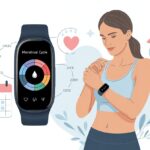Let’s be real—keeping tabs on our kids sometimes feels like a full-time gig. If only we actually had eyes in the back of our heads! Wouldn’t that be something? Luckily, smartwatches have made it a lot easier to stay connected with our little ones, without having to wrap them in bubble wrap or lurk behind bushes like some sort of spy.
With a smartwatch, we can track our child’s location and get instant safety updates. It’s a game-changer for peace of mind—and maybe, just maybe, we’ll actually finish a cup of coffee while it’s still hot.

These gadgets do more than just tell time. GPS tracking, messaging, and SOS alerts are just the start.
Some smartwatches let us set emergency contacts, or simply share locations, so we always know if our little explorer has wandered to the park or “disappeared” into the neighbor’s yard. If you want to see how these things work, there’s a quick setup walkthrough for a kids tracking smartwatch online.
So, if you’re ready to level up your parenting game (and maybe chill out a bit), let’s get into the basics of tracking our kids with a smartwatch—no superhero cape required.
Why Use a Smartwatch for Kid Tracking?
Keeping up with kids feels a bit like chasing squirrels after they’ve had way too much sugar. Smartwatches let us track their location and give everyone a bit more freedom—and maybe save us a few gray hairs.
Peace of Mind for Parents
Parenting comes with a free side of worry, right? Smartwatches with location tracking or GPS take some of the mystery out of our day.
We don’t have to wonder if the bus dropped them off or if they made a detour for ice cream. Real-time maps let us check in without embarrassing anyone at school pickup.
If something unexpected pops up, we get notified before our hearts jump out of our chests. Many top smartwatches for kids let us set “safe zones,” so if our child leaves their allowed area, we get an instant alert.
This means we can stop giving the playground crowd suspicious glances. And with two-way communication, we can call or text—even if their phone is buried at the bottom of their backpack again.
Want more info on secure messaging and unknown caller protection? Check out this list of the best smartwatches for kids.
Empowering Kids with Independence
We want our kids to explore, but we also want to know where they’ve wandered off to (without hiding cameras in their sneakers). A smartwatch gives them a taste of independence.
They can walk to a friend’s house or ride their bike to the park, knowing we’re just a tap—or a slightly embarrassing call—away.
It’s not just about tracking them. Kids can send a quick message or call if they need help or want to brag about climbing the “world’s tallest tree” (which is probably the short one by the bench).
Some watches even track steps, chores, or homework, teaching them a bit of responsibility. By letting them roam within agreed boundaries, we show trust and help build their confidence.
And yes, we still keep that digital leash handy—just in case.
Choosing the Right Kid’s Smartwatch
When we’re shopping for a kid’s smartwatch, we can’t just grab the shiniest thing on the shelf. We have to balance safety features, durability (because, kids), and styles our children will actually want to wear—not lose under their bed.
Essential Features to Look For
We need more than a cute watch face. The best smartwatches for kids usually have GPS tracking so we know where our little ones are—even if they claim they’re “almost home.”
A solid SOS button is a must, so our kids can call for help if needed (instead of sending fifty texts). Two-way communication lets us reach out without causing classroom chaos with a blaring ringtone.
Battery life matters—a lot. We don’t want to chase after a device that dies before lunchtime. It’s smart to choose watches that let us set location boundaries or alerts, so we get a heads up if our child wanders.
Some options, like the Gabb Watch 3e, get high marks for safety and tracking.
Durability and Kid-Proofing
Kids test everything—including stuff we specifically tell them not to. That’s why we look for watches with water resistance, because splashing is apparently a competitive sport.
A shatter-resistant screen helps the smartwatch survive playground battles. The strap matters too—a comfy, adjustable band stays on little wrists without pinching or slipping off in the middle of tag.
Some watches even claim to be drop-proof or shock-proof, which is basically code for “built for wild children.” The materials should be safe and non-toxic, since, let’s face it, everything is a chew toy to a kid.
Kid-Friendly Designs
Style is a big deal for our kids, even if we’d rather focus on the practical stuff. Fun colors, cool watch faces, and themed designs make wearing a smartwatch more exciting—and maybe help kids remember to put it on.
Touch screens should be bright and simple to use, even for sticky fingers. Big icons and easy navigation make a difference for young users who’d rather play than read a manual.
Some brands add reward systems, games, or activity trackers to sweeten the deal—turning every step or completed chore into a little win. For more on the best styles and models, check out this guide to the best kids smartwatches.
Setting Up Your Child’s Smartwatch
Setting up a smartwatch for kid tracking feels a bit like prepping superhero gear. We want the process to be as smooth as possible—just enough tech magic, not too much stress.
Charging the battery and keeping details straight are key.
Pairing with the Companion App
First, we download the companion app from the App Store or Google Play. This app is our control center—where we track locations, enter commands, and fix whatever settings the kids “accidentally” change.
After charging the watch, we turn on Bluetooth on our phone and put both devices close together. The smartwatch shows a code or a bouncing icon, and we match it up in the app.
If the watch asks for a Wi-Fi password, we enter it (and maybe mutter under our breath). Each app looks a bit different, but most guide us through the steps.
Once the app and watch are paired, they start sharing data, locations, and notifications. Now, battery life becomes our next focus—make sure to fully charge the watch before heading out, so it tracks all day and doesn’t leave us with a “low battery” scare.
Creating User Profiles
Now for the fun part: setting up a user profile. We enter our child’s name, age, and maybe even pick a fun avatar.
This profile tells the watch who it’s tracking and who’s allowed to contact or locate our little adventurer. Usually, we can add emergency contacts—grandma, a neighbor, or even the family dog (if he answers calls).
Most watches want us to create a strong password, so sneaky siblings don’t take over. Some let us set up school hours, so the watch stays quiet during class—saving battery and avoiding awkward interruptions.
If the watch has different access levels, we give ourselves “all-seeing parent” mode, while our child gets the basics. With a few taps (and probably one “forgot my password” moment), the watch is ready to keep our kids connected and tracked—no secret agent badge needed.
If you want a visual walkthrough, setup videos like this one for SeTracker GPS watches can help if you get stuck.
Using Location Tracking and Geolocation
Our kids move fast—sometimes faster than our Wi-Fi on a Monday. Smartwatches with GPS help us keep up, track their locations, and set up digital boundaries so they stay where they’re supposed to.
Setting Safe Zones and Geofencing
Setting up safe zones (or geofencing) is like building an invisible fence—without the dog collar. We pick important places like home or school, and the smartwatch lets us know if our child crosses those boundaries.
Most smartwatches have a phone app where we set these borders by dropping pins or marking areas on a map. Once we set the area, the watch sends us a notification if our kid wanders out.
This is super helpful in busy places (birthday parties, anyone?) or if our child has a knack for disappearing acts. Some watches let us set more than one safe zone, so we can monitor school, grandma’s house, and even soccer practice.
Want a closer look? Here’s a guide on setting up safe zones with a kid’s smartwatch.
Viewing Real-Time Location
We can check where our child is at any time with real-time GPS tracking. Just open the smartwatch app, tap on location or map, and there’s our kid—hopefully not halfway to the next state.
Real-time tracking usually updates every few minutes, but some watches refresh even faster if we need it. Some devices let us request instant updates, though that can drain the battery quicker—trade-offs, right?
Most apps also show a location history, so we know if our kid really went straight home or took a detour for ice cream. Devices like the Bark Kid’s Smartwatch offer live tracking and location alerts to keep us in the loop and a little less anxious.
Communication Features for Connected Kids
Nothing beats being able to reach our kids when we need to—or when they can’t find their left shoe for the millionth time. Kid smartwatches come packed with tools for easy, safe two-way communication.
Two-Way Calls and Voice Messaging
Let’s be real—kids usually find it way easier to tap a button than type out a whole message. Most kids’ smartwatches handle two-way calling, so we can call them or they can call us. This comes in handy, especially when it’s pickup time after another endless soccer practice.
We set up a limited contact list through a companion app. That way, unknown callers stay out, and Aunt Marge in New Jersey won’t get random calls. Sometimes talking isn’t possible—maybe they’re whispering in the library or knee-deep in a mud fort.
That’s when voice messaging saves the day. Kids just record a quick message and send it off—no frantic texting or spelling worries.
We get to hear their voices, even if they’re too busy to answer. Honestly, it’s a win for parents and giggling kids who love sending silly audio clips.
If you want more details, check out this smartwatch guide for kids.
Sending and Receiving Text Messages
Some days, our kids have a lot to say. Other days, it’s just an emoji (🦖 shows up a lot). Kids’ smartwatches let them send short text messages to approved contacts—nobody’s writing novels on these screens.
We control the contact list, so strangers can’t sneak in. With texts, kids can tell us if the bus is late, ask for a snack, or just say, “Hi!”
Quick messages are perfect for reminders—like “Don’t forget your lunch!” or “Remember your homework!” Many devices offer easy-to-use texting features that really do make life simpler for both kids and parents.
Safety Features: SOS Button and Emergency Alerts
When it comes to safety, we want peace of mind. Smartwatches now pack in helpful features like the SOS button and real-time emergency alerts.
These keep little explorers—and honestly, us—out of trouble.
How the SOS Button Works
The SOS button is basically a superhero in disguise. If our child feels unsafe or needs help, they just press and hold the SOS button for a few seconds.
As soon as they do, the watch sends alerts to our chosen emergency contacts. Some watches, like SECULIFE and TickTalk, even call us automatically or send live location details.
The watch might buzz or beep to let our child know help is on the way. No capes needed.
Customizing Emergency Contacts
Let’s be honest, not every scraped knee needs to involve Grandma. Most kids’ smartwatches let us add and edit emergency contacts easily, right from the phone app or watch settings.
Here’s how we usually do it:
- Pick contacts like parents, a trusted neighbor, or that super-responsible aunt.
- Decide who gets notified first, second, and so on.
- Double-check phone numbers—nobody wants to call the pizza place by accident during an emergency.
Watches like the Bark Kid’s Smartwatch make this process straightforward. Less fumbling, more actual parenting.
Maximizing Smartwatch Battery Life
Honestly, a dead kid’s smartwatch isn’t tracking anyone—not even the family dog. To keep our little one’s tracker powered up, we need to charge it smartly and tweak a few settings that quietly drain the battery.
Charging Tips and Schedules
If you’re like us, you probably forget your own phone charger sometimes. Remembering to charge a kid’s smartwatch can feel like a big ask.
But making it part of the nightly routine—maybe next to brushing teeth—makes things easier. Charging at the same time every night avoids those frantic school mornings.
Charging only when the battery drops below 20% helps the battery last longer.
Here’s a quick checklist:
- Use the original cable (finding a replacement is nearly impossible)
- Keep the charging port clean—lint belongs in pockets, not gadgets
- Don’t overcharge; even smartwatches get cranky if plugged in forever
Tiny habits now prevent those “Why aren’t you at school?” moments later.
Battery Preservation Settings
Our kids don’t need their watches buzzing all day. Adjusting a few settings can stretch battery life.
Turning down screen brightness saves power and keeps notifications from blinding everyone at dinner. Cutting down on unnecessary notifications helps too—every game invite or weather alert is just a battery thief.
Set the display to turn on only when buttons are pressed, not every time a wrist moves. Many smartwatches have power-saving modes for emergencies.
For more tips, check out these guides on extending smartwatch battery life or maximizing battery life. These settings help the watch last till bedtime—and maybe even through a sneaky snack raid.
Keeping Your Child’s Data Secure
Let’s be honest, we want to know where our kids are—but we definitely don’t want the whole world to know too. Staying on top of privacy settings and safe habits keeps our families out of the internet’s spotlight.
Privacy Settings and Permissions
First step: dive into the privacy menu like it’s a treasure chest. Always pick strong passwords and turn on two-factor authentication if it’s available.
It might feel like a hassle, but it’s way better than getting weird emails about someone logging in from who-knows-where. Most smartwatches let us control what data gets shared—location, contacts, even step counts (because no one else needs to know if the kids only took ten steps in gym).
Setting permissions is easy—just toggle off what you don’t need. If an app wants access to every photo, it’s fair to ask, “Why?”
Keep the software up to date. Updates fix bugs and patch security holes. Think of it as spring cleaning, but with less dust.
Safe Sharing Practices
If we share our child’s location, let’s do it strictly on a need-to-know basis. Grandma and the school nurse? Sure. That friendly neighbor’s hamster? Probably not.
Oversharing puts privacy at risk. Before posting screenshots or updates, double-check what’s visible. Accidentally sharing your child’s location online is a fast way to invite trouble—and it’s a pain to undo.
Some apps let us limit who sees shared data. Always look for options for private groups or specific contact lists.
We should also talk to our kids about personal info. Remind them not to share their location or password—even if someone offers free pizza. Gotta keep our “pizza password” safe for special occasions.
Encouraging Responsible Smartwatch Use
Let’s not kid ourselves—handing over a shiny new smartwatch doesn’t magically turn kids into responsibility superheroes. We need structure, some trust, and maybe a few deep breaths.
Setting Usage Rules
First, let’s sit down and agree on some rules. Smartwatches aren’t meant for all-access, anytime fun.
We can set time limits, like using the watch only during certain hours or after chores are done. Features like “classroom mode” disable distractions during study time, so kids can’t claim their math homework got “lost in the apps” (read more).
We should also agree on when location tracking is okay. If our young secret agents ever ask, “Are you tracking me right now?” we answer based on what we agreed to—not on a sudden urge to play detective.
Make a simple list together:
- Times for watch use (school, after-school activities)
- App or feature restrictions
- Daily screen time limits
- When location tracking is on
Posting these rules somewhere visible—like the fridge, next to the pizza coupons—keeps everyone on the same page.
Building Trust with Open Communication
Honestly, nothing beats just talking things out. If we want our kids to feel safe wearing a smartwatch, we should come clean about what the tracking features actually do and why they’re there in the first place.
Let’s skip the classic “because I said so.” Instead, we can share real reasons—like making sure they’re safe or checking if they made it to soccer practice.
Encourage questions, even the tough ones. When our tech-savvy kids start grilling us about privacy, there’s no need to panic.
Invite open conversations. We can chat about when it’s okay for parents to see their location and when maybe it’s not.
This should feel like a team effort. Remind your kids that trust goes both ways—less sneaking around, more sharing, and, who knows, maybe fewer dramatic spy moments at home (learn how to set these limits).
- Why is my fitness tracker not pairing with Apple Health? Troubleshooting for Technologically Cursed Mortals - December 22, 2025
- Why is my fitness tracker not updating firmware? Tech Tantrums and Update Woes Explained - December 21, 2025
- Why is the Sound Quality on My Bluetooth Headphones Poor? It’s Not Just Bad Music Taste! - December 21, 2025






